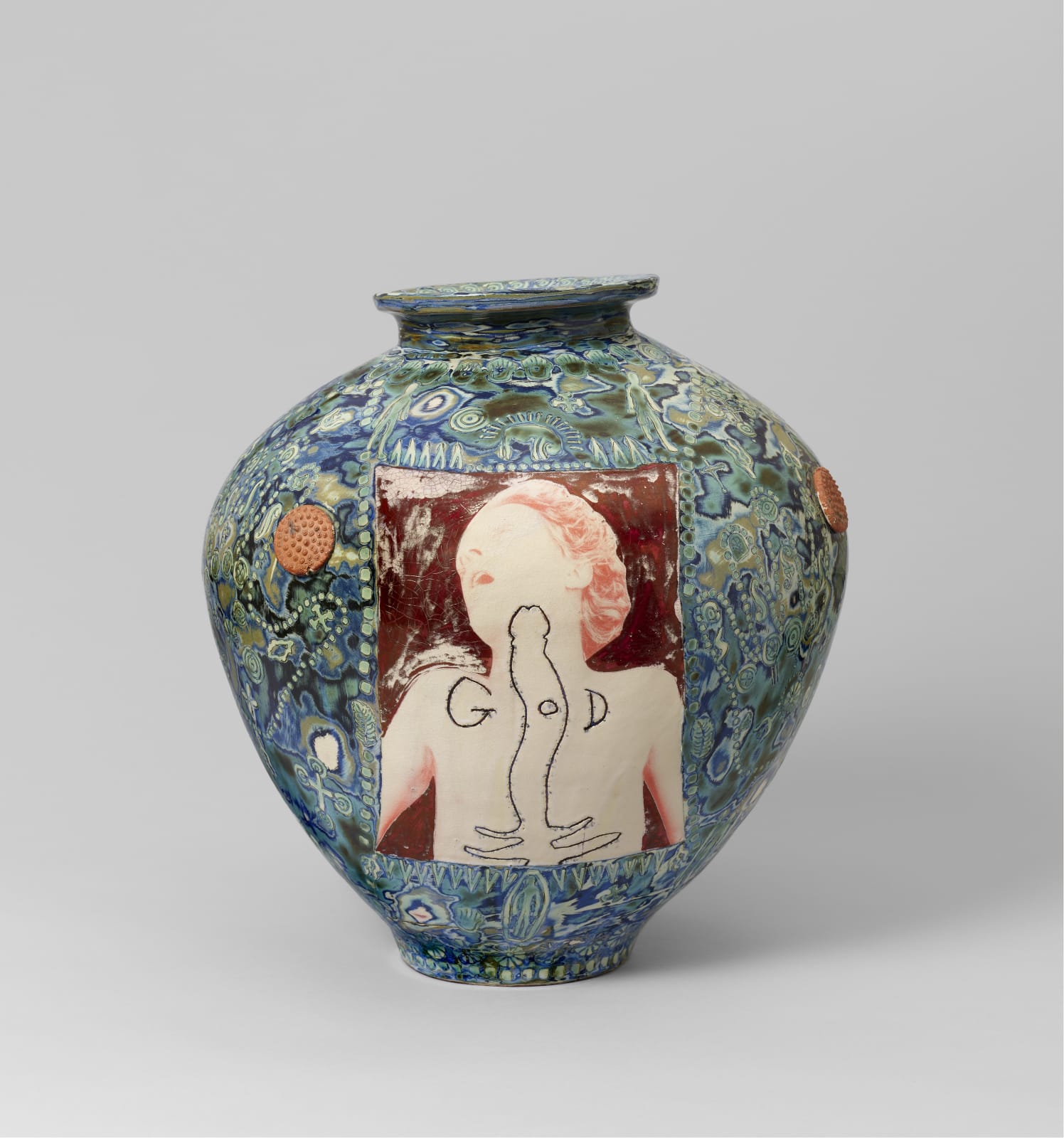Grayson Perry b. 1960
Pseudo Spiritual Clap Trap, 1998
glazed earthenware
15 x 11 1/8 x 11 1/8 inches
38.1 x 28.3 x 28.3 cm
38.1 x 28.3 x 28.3 cm
Further images
Pseudo Spiritual Clap Trap makes use of all Grayson Perry’s signature techniques – photo transfers, line drawings, typography, decorative glazes, sprig moulds – to explore the big themes of sex,...
Pseudo Spiritual Clap Trap makes use of all Grayson Perry’s signature techniques – photo transfers, line drawings, typography, decorative glazes, sprig moulds – to explore the big themes of sex, art and God. The most prominent aspect of its design are three red-toned photo transfers, two of which show Perry himself. Under the word ’Sex’, he is dressed as a suburban housewife wearing a dated 1980s blouse. A larger version of this photo appears on the pot Contained Anger, 1999, where it becomes apparent that he is also wearing handcuffs. Perry’s transvestism, which began in his teens and is poignantly described in his 2006 autobiography, Portrait of the Artist as a Young Girl, is a constant subject within his work. In his art, Perry presents this aspect of himself at one remove and, as such, one might misread his female persona Claire as part of an act. But as Jacky Klein explains, ‘The power, pathos and oddness of his transvestism lie not in its status as performance. This is no mere stunt: his is a publicly played out compulsion – one rooted in rejection, unhappiness and the need to be loved simply for being oneself.’ 1
The second image, ’God’, frames Perry’s head and naked torso in a Christlike or, possibly, autoerotic pose. Another photo from the same series appears on another 1998 pot, I Am My Own God, in which Perry stands on a stepladder between two large vases, posing, not as Christ, but rather as a classical Greek statue. In the earlier work, My Gods, 1994 (Tate Collection), Perry invents Gods to oversee different aspects of his own experience, including ‘the god of quiet machismo’ and the ‘god of imagination’. He later reflected that ‘when you’re a child, your gods are whoever you’re told they should be … An innocent child worships gods that have aspects of its parents in them: there’s a sort of projection of parent onto god’.2 The subject of God then has less to do with questions of religious faith, and more with his experience of psychotherapy and his troubled relationship with his parents.
The third transfer, labelled ’Art’, shows a young and gamine Sadie Coles. Coles, now one of Britain’s most successful contemporary art dealers, was then working for Anthony d’Offay, at whose gallery Perry showed in 1994 and 1996 –9 7. The skull and crossbones over her face don’t seem malicious in intent – perhaps she is an angel of the art world. It is under her image that we find the text ‘pseudo spiritual clap trap’. The theme of pseudo-spirituality is continued in the tiny images, sacred and profane, scattered over the surface, including flowers, hands, vaginas, coffins and crosses.
1 Jacky Klein, Grayson Perry, Thames & Hudson, London, 2009, p127
2 Tate Gallery website, the artist quoted in Jacky Klein, Grayson Perry, Thames & Hudson,
London, 2009, p176
The second image, ’God’, frames Perry’s head and naked torso in a Christlike or, possibly, autoerotic pose. Another photo from the same series appears on another 1998 pot, I Am My Own God, in which Perry stands on a stepladder between two large vases, posing, not as Christ, but rather as a classical Greek statue. In the earlier work, My Gods, 1994 (Tate Collection), Perry invents Gods to oversee different aspects of his own experience, including ‘the god of quiet machismo’ and the ‘god of imagination’. He later reflected that ‘when you’re a child, your gods are whoever you’re told they should be … An innocent child worships gods that have aspects of its parents in them: there’s a sort of projection of parent onto god’.2 The subject of God then has less to do with questions of religious faith, and more with his experience of psychotherapy and his troubled relationship with his parents.
The third transfer, labelled ’Art’, shows a young and gamine Sadie Coles. Coles, now one of Britain’s most successful contemporary art dealers, was then working for Anthony d’Offay, at whose gallery Perry showed in 1994 and 1996 –9 7. The skull and crossbones over her face don’t seem malicious in intent – perhaps she is an angel of the art world. It is under her image that we find the text ‘pseudo spiritual clap trap’. The theme of pseudo-spirituality is continued in the tiny images, sacred and profane, scattered over the surface, including flowers, hands, vaginas, coffins and crosses.
1 Jacky Klein, Grayson Perry, Thames & Hudson, London, 2009, p127
2 Tate Gallery website, the artist quoted in Jacky Klein, Grayson Perry, Thames & Hudson,
London, 2009, p176
Provenance
Laurent Delaye Gallery, London
Private Collection, UK, acquired from the above in October 2000





